
U.S. Navy smoking policy at war with itself
Last Thursday, November 18, as part of the 35th Great American Smokeout (GASO), I had the honor of presenting nicotine dependency recovery programs to our military's brightest, students at the U.S. Navy's Nuclear Power Training Command (NNPTC) here at the Naval Weapons Station (NWS) in Goose Creek, South Carolina. After two gymnasium seminars, extensive give and take questioning, and a bit of digging, I'm forced to report that U.S. Navy smoking policy is in a state of serious conflict.
Conflicting Smoke Signals
 A former nine-year submarine service veteran myself, it was as if revisiting 27 year-old roots. But in regard to smoking, those roots had changed, both at boot camp and in the fleet. Unlike my basic training experience, the sailors before me were all graduates of an eight week Navy boot camp that was 100% tobacco-free. Little good it had done, as each had relapsed.
A former nine-year submarine service veteran myself, it was as if revisiting 27 year-old roots. But in regard to smoking, those roots had changed, both at boot camp and in the fleet. Unlike my basic training experience, the sailors before me were all graduates of an eight week Navy boot camp that was 100% tobacco-free. Little good it had done, as each had relapsed.
Once again hooked, most of these students are headed for duty aboard America's 71 nuclear powered submarines, where after December 31, 2010 smoking will be banned below decks per order of the Commander of Submarine Forces.
My primary concern was, why? Why had these new sailors relapsed? And why would my Navy, which had sandwiched them between two smoke-free duty stations, fail to realize and appreciate the critical role it was playing in helping facilitate their relapse?
Prior to, during and after my GASO presentations I studied their environment. I visited the base's Navy Exchange, Mini-Exchange and Commissary, all of which openly sell and market tobacco products at prices roughly 20% cheaper than available off-base. For example, a carton of Marlboros today sells in the Navy Exchange for $42.00 while the same carton is available down the road at Publics supermarket for $52.48. The primary difference is taxes, as military tobacco is tax free.
The base Mini-Exchange sits 625 feet from the NNPTC school barracks complex, home to 2,500 intellectually gifted students. There, store tobacco marketing displays aggressively tease, torment and beg recent ex-smokers to purchase cigarettes, cigars and oral tobacco products, to use them and relapse.
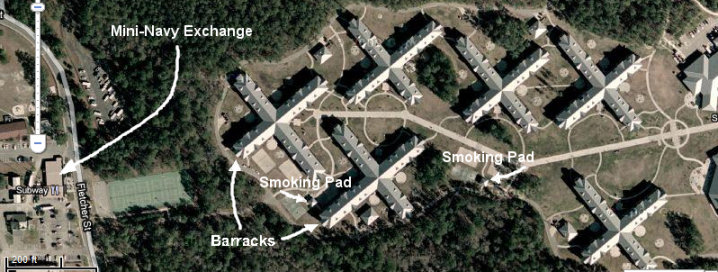
Like most convenience stores, it is impossible for students to make any Mini-Exchange purchase without standing in front of a tobacco display power-wall that screams "buy me" and "smoke me!"
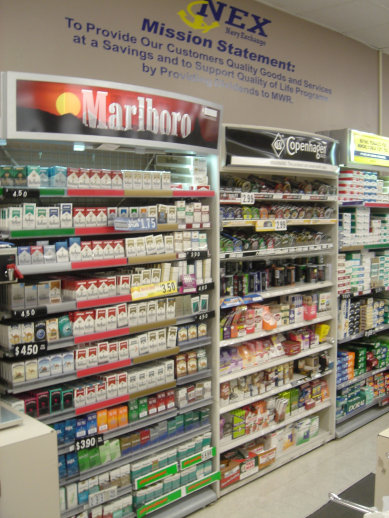 Oddly, the Navy Exchange's "Mission Statement" is displayed directly above the tobacco power-wall. In my mind I saw it as reading, "Mission Statement: To chemically enslave as many of our sailors and their dependents as possible, to the cheapest nicotine products anywhere."
Oddly, the Navy Exchange's "Mission Statement" is displayed directly above the tobacco power-wall. In my mind I saw it as reading, "Mission Statement: To chemically enslave as many of our sailors and their dependents as possible, to the cheapest nicotine products anywhere."
A separate Mini-Exchange cigar case display sits beneath a large blue and gold ceiling sign which reads, "Navy Pride."
I attempted to obtain permission to enter and photograph the NWS Commissary's tobacco marketing display but after the store manager made a call to her supervisor I was denied.
In contrast, I'm told that the entire Great Lakes Recruit Training Command (RTC) is a tobacco-free campus, including the Navy Exchange Recruit Store, Building 1326.
Upon graduating from RTC, recruits being assigned to NNPTC are flown here to Charleston prior to being granted leave. Upon arrival at NNPTC, the new recruits are immediately struck by the irony that the Navy constructed and layed out the NNPTC campus so as to encourage student smoking.
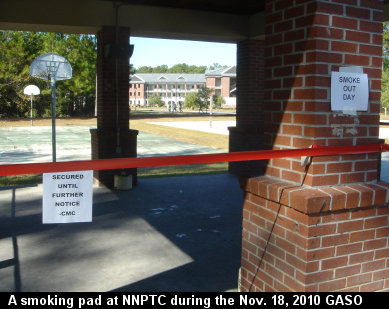 The Navy has built covered smoking pads that dot the campus. No visibility barriers, newly arriving RTC ex-smokers walking about campus are teased and compelled to watch as clouds of smoke bellow forth from these highly popular
student gathering spots.
The Navy has built covered smoking pads that dot the campus. No visibility barriers, newly arriving RTC ex-smokers walking about campus are teased and compelled to watch as clouds of smoke bellow forth from these highly popular
student gathering spots.
"When I first arrived from boot camp I didn't know anyone," said a female GASO seminar student. "I saw smoking and the smoking pads as a way to meet other students."
But when queried, the most common reason given for relapse following boot camp was that the new sailor never really quit. Instead, in their mind and thinking, like often seen during pregnancy, they had only temporarily suspended smoking during basic training, after being compelled to stop.
"I couldn't wait until graduation," a male student said. "I knew when I joined that smoking was permitted at NNPTC and bought my first pack at the airport." A number of heads nodded in agreement.
Need for Boot Camp Relapse Prevention Instruction
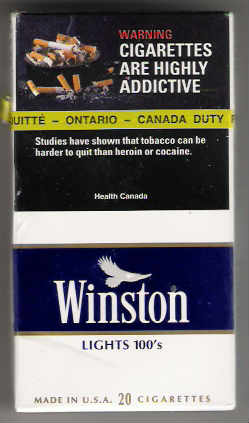 NNPTC student-sailors aren't alone when it comes to relapse. A 2000 study found that 89% of female recruits who were daily smokers upon joining the Navy had relapsed to smoking within three months of graduation from smoke-free basic training.
NNPTC student-sailors aren't alone when it comes to relapse. A 2000 study found that 89% of female recruits who were daily smokers upon joining the Navy had relapsed to smoking within three months of graduation from smoke-free basic training.
A 2004 relapse prevention study entitled "Operation Stay Quit" followed female RTC graduates who had quit smoking during basic training. It examined the impact of either sending them monthly reinforcement mailings following graduation or making relapse prevention telephone counseling available to them. Researchers found no benefit from either intervention.
My GASO objective was to teach the latest science as to how nicotine enslaves the mind's priorities teacher by activating, saturating, and up-regulating brain dopamine pathway receptors. I shared how dopamine infuences survival instinct priorities inside a healthy brain, how chemical dependency puts nicotine first, and how drug addiction is about living a lie. Most importantly, I wanted each to walk away fully accepting the fact that we are true drug addicts in every sense, that we only have two choices, freedom or that next fix.
Why? Because dependency acceptance greatly simplifies the rules for both successful recovery and relapse prevention. In fact, there's really only one rule: no nicotine today.
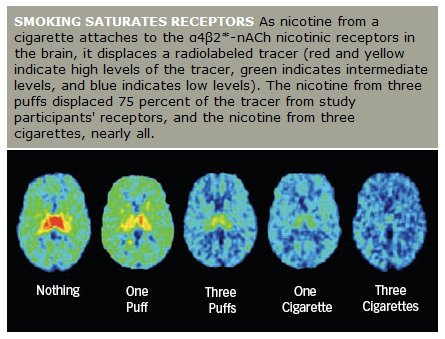 Brain scans evidence how smoking nicotine just once following cessation saturates dopamine pathway receptors. While roughly half who smoke just once after quitting walk away from relapse thinking they've gotten away with it, nearly all soon sense their brain begging for more.
Brain scans evidence how smoking nicotine just once following cessation saturates dopamine pathway receptors. While roughly half who smoke just once after quitting walk away from relapse thinking they've gotten away with it, nearly all soon sense their brain begging for more.
Following my NNPTC GASO presentations I shared my experience with Joel Spitzer of Chicago, the author of popular free e-book "Never Take Another Puff" (NTAP has recorded more than two million downloads). Having presented more live quitting clinics and seminars during his 36 year full-time counseling career than possibly any person ever, I see Joel Spitzer as America's Babe Ruth/Henry Aaron of smoking cessation.
Living in Chicago (Evanston), Joel was well aware of the smoking policy at the nearby Great Lakes Navy RTC complex. It was his opinion that Navy recruit relapse prevention could benefit significantly by a one hour presentation during week seven of basic training (the week prior to graduation). He suggested that it be recorded and emphasize chemical dependency, the price of relapse and the "Law of Addiction."
Although the leading cause of preventable illness, disease and disability within the military, the Department of Defense (DOD) and Navy continue to act as though addiction to smoking nicotine is somehow different and less serious than other chemical dependencies.
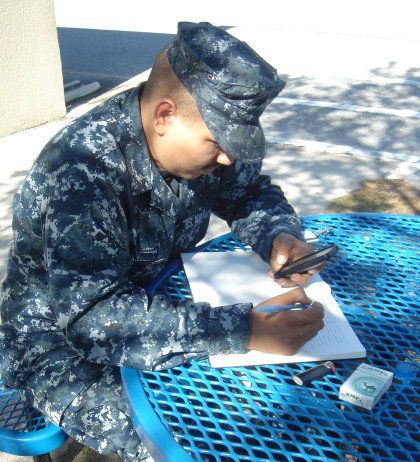
Nicotine is an alkaloid. Under normal conditions it has roughly a two-hour blood serum half-life. Stress is an acid producing event within the body. Like the instant bubbling seen when pouring a liquid baking soda solution (an alkaloid) over an acid covered car battery terminal, the more stressed the smoker becomes the faster nicotine is eliminated from the bloodstream.
Our Admirals and Generals need to understand that smoked nicotine does not relieve stress. For example, if the stress was induced by experiencing a flat tire, once nicotine replenishment is complete the tire is still flat. The relief sensed is due to replacement of missing nicotine. After years of adding early withdrawal to every stressful event, one of recovery's greatest benefits is an amazing sense of calm during crisis.
Tobacco's Costs 21 Times Greater than Profits
What logic is there in eliminating smoking and tobacco use while in basic training and then actively encouraging recruits to relapse after graduation? I understand that the Navy and DOD may have a significant conflict of interest in eliminating tobacco marketing and sales on military bases, as a major portion of tobacco sale proceeds are used to fund base morale, welfare and recreation programs. But the DOD needs to sleep on the math.
Annual profits from all DOD authorized military tobacco sales are at most $90 million, while a June 2009 study commissioned by the DOD reported that annual tobacco related military health care costs and lost productivity were 21 times greater at $1.9 billion. Additionally, the study reported that the Department of Veterans Affairs spends a whopping $5 billion annually to treat COPD, which is predominately smoking related.

The June 2009 study, produced by the National Academy of Science's Institute of Medicine, made the following recommendations to the DOD:
- Stop selling tobacco products in military commissaries and exchanges. Until accomplishing that, DOD should at the very least sell tobacco products at prices equal to those in local civilian retail stores.
- Prohibit tobacco use anywhere on military installations.
- Treat tobacco use in the same way as other health-related behaviors, such as alcohol abuse and poor physical fitness, which impair military readiness.
Regarding readiness, the National Academy of Science knows that bloodstreams filled with carbon monoxide, half of which continues to circulate four hours after that last puff, affect physical endurance and threaten the mission by making prolonged periods of vigorous physical activity range from challenging to impossible. Chronically inflamed bronchial tubes and tar drenched lung tissues add to the challenge.
Tobacco: a True Weapon of Mass Destruction
The Academy knows that 32 percent of active duty military personal smoke nicotine, a rate 52% higher than the 21 percent rate seen among non-military smokers. The Academy's ignored recommendations allow the continued gradual destruction of the minds and bodies of roughly one-third of our military.
A true weapon of mass destruction, the DOD and Navy know that chemical dependency upon nicotine is a brain dopamine pathway "wanting" disorder, a DSM-IV and ICD-10 mental illness and disease for which there is no cure.
They know that smoking destroys brain gray matter, diminishes impulse control, fosters depression, is responsible for one-third of all cancers, including 87% of lung cancers, doubles to quadruples risk of coronary heart disease (America's leading cause of death), doubles risk of stroke, causes chronic bronchitis in 49% of current smokers, emphysema in 24% of current smokers, delays wound and fracture healing, and significantly elevates military sickness and absenteeism rates.
Battling Dependency Means Battling DOD Tobacco Policy
NNPTC isn't alone. Nearly all other submarine "A" schools providing basic training for other rates are based with the Navy's submarine school in New London (Groton) Connecticut. There, not only do students endure the influence of Navy Exchange and Commissary tobacco marketing, so do submariners attempting to prepare for that first smoke-free patrol.
Today, a carton of Marlboros in the sub base's Main Store Exchange (BLDG# 484) sells for $51.00, $9.00 more per carton than here in the NWS Exchanges. I was unable to confirm whether or not cigarettes are also sold at the Dolphin Mini Mart.
How can base, unit and sub commanders ensure the health and well being of their units and crews when DOD health leadership demonstrates so little concern for chemical dependency or its consequences? It's mission impossible. But that doesn't mean they're not trying.
Not only did NNPTC invite us in during GASO to address dependent students, it extinguished the smoking lamp on the entire NNPTC campus during the Smokeout. Sitting between tobacco-free basic training and a tobacco-free submarine fleet, NNPTC daily lives the lunacy of the Navy Exchange actively marketing nicotine to its students and staff.
Military health policymaker opinions are changing but not quickly enough to save our sailors, soldiers and airmen from having to face the greatest challenge many will ever know, attempting to arrest their chemical dependency upon nicotine one more time.
A new study published in the October 2010 edition of Military Medicine interviewed 16 health policy leaders from all branches of the military. Collectively, while 56% felt that it was likely that smoking would eventually be banned while wearing a military uniform, only 13% felt smoking would be banned on the entire base, and only 19% believed that significant restrictions would be placed on base cigarette sales.
It's time for Pentagon group think to end this health insanity. Our service men and women deserve more than a cyber-site suggesting that they quit (www.ycq2.org), a site whose primary partner is the Navy Exchange.
They deserve real-world stores, schools, boats, ships and bases that encourage, foster and support nicotine dependency recovery, neuro-chemical freedom, long overdue tissue healing, and long-term relapse prevention.

